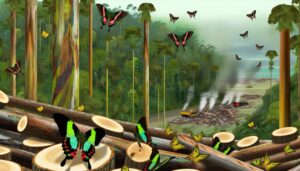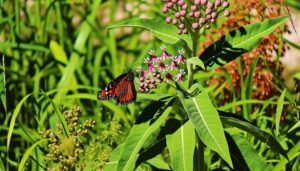How Do Queen Alexandra Birdwing Butterflies Eat?
Queen Alexandra Birdwing butterflies exhibit intricate dietary preferences throughout their lifecycle. Early-stage caterpillars consume leaves of Aristolochia schlecteri, gaining essential alkaloids for defense and growth.
These larvae rely exclusively on Aristolochia species, creating a symbiotic ecological relationship. Adult butterflies primarily feed on nectar from flowers such as Mucuna, Hibiscus, and Lantana species, utilizing their long proboscises for efficient extraction.
Adult nutritional intake includes nectar-rich sugars, salts, and amino acids, vital for longevity and reproductive success. This dietary specialization underscores the butterfly's survival, highlighting the importance of specific host plants and nectar sources in their ecology.
Discover more about the Queen Alexandra Birdwing's unique dietary adaptations.

Key Takeaways
- Queen Alexandra Birdwing caterpillars primarily consume leaves of Aristolochia schlecteri, containing vital toxic aristolochic acids.
- Adult butterflies feed mainly on nectar from flowering plants like Mucuna, Hibiscus, and Lantana species.
- Nectar from tropical flowers provides essential sugars and energy for adult butterflies' metabolic activities.
- Caterpillars rely on Aristolochia plants for nutritional alkaloids crucial for their development and chemical defense.
Early Caterpillar Diet

The early caterpillars of Queen Alexandra's birdwing butterflies primarily consume the leaves of the Aristolochia schlecteri plant, which contain toxic aristolochic acids that provide a chemical defense against predators.
These aristolochic acids serve not only as a deterrent to potential threats but also confer the larvae with a form of chemical protection, making them less palatable to their natural enemies.
The ingestion of these compounds is essential for the caterpillar's survival during its vulnerable early stages.
The specialized diet necessitates a symbiotic relationship with the host plant, facilitating both growth and chemical defense.
This dietary specialization underscores the intricate ecological interactions and evolutionary adaptations that these caterpillars have developed in response to their environment.
Host Plants
The Queen Alexandra's birdwing butterfly primarily relies on Aristolochia species as its host plants, which are essential for the survival of its larvae.
These plants provide important nutrients that support the larvae's growth, influencing their feeding behavior and developmental success.
Understanding the specific interactions between the larvae and their preferred host species is critical for conservation efforts aimed at preserving this endangered butterfly.
Preferred Host Species
Queen Alexandra's birdwing butterflies primarily rely on specific species of Aristolochia plants as their host plants for laying eggs and providing nourishment for their larvae. Among these, Aristolochia tagala and Aristolochia schlecteri are particularly favored.
These plants contain unique alkaloids that are essential for the larvae's development and confer chemical defense mechanisms against predators. The butterflies exhibit ovipositional preferences, meticulously selecting young, tender leaves for egg deposition.
The specificity of their host plant selection underscores the intricate co-evolutionary relationship between the Queen Alexandra's birdwing and Aristolochia species. Consequently, the availability of these Aristolochia species in their native habitats greatly influences the distribution and survival of this endangered lepidopteran species.
Larval Feeding Behavior
Larvae of Queen Alexandra's birdwing butterflies exhibit specialized feeding behavior, primarily consuming the tender leaves of their preferred Aristolochia host plants to acquire necessary alkaloids for growth and defense.
The ingestion of these alkaloid-rich leaves serves not only as a nutritional source but also imparts chemical protection against predators. This selective feeding guarantees that the larvae efficiently assimilate aristolochic acids, which deter potential threats by making the larvae unpalatable.
The preference for specific Aristolochia species, such as Aristolochia tagala, aligns with the larvae's evolutionary adaptations to these toxic compounds.
Consequently, the larval stage is characterized by meticulous feeding patterns that maximize the intake of essential chemicals, facilitating both physiological development and enhanced survivability within their ecological niche.
Nutritional Needs

Among the primary nutritional requirements of Queen Alexandra Birdwing butterflies are the specific alkaloids and nectar sourced from Aristolochia schlecteri, their host plant.
These alkaloids are essential for the larvae, as they provide necessary chemical compounds required for their development and defense mechanisms. The larvae consume the leaves, which are rich in toxic aristolochic acids that serve as a deterrent against predators.
Additionally, the nectar from this plant supplies important sugars and energy needed for metabolic activities and growth. The precise balance of these nutritional components supports the physiological and biochemical processes fundamental for the larvae to progress successfully through their development stages.
This specialized diet underscores the butterfly's dependency on Aristolochia schlecteri for survival and proliferation.
Adult Butterfly Diet
Feeding primarily on the nectar from a variety of flowering plants, adult Queen Alexandra Birdwing butterflies exhibit a diet that supports their high-energy demands for flight and reproduction. Their proboscis, an elongated feeding tube, allows efficient extraction of nectar, rich in carbohydrates, essential for sustained energy levels.
Additionally, these butterflies occasionally engage in mud-puddling, a behavior where they ingest salts and amino acids from moist substrates. This supplemental intake is critical for their metabolic processes and fecundity, enhancing reproductive success.
Moreover, the dietary intake of adult Queen Alexandra Birdwings directly influences their longevity and vigor, as the nutrients absorbed from nectar play a pivotal role in maintaining their physiological functions and supporting their intricate life cycle.
Nectar Sources

Queen Alexandra Birdwing butterflies primarily source nectar from a diverse array of tropical flowering plants, including species from the genera Mucuna, Hibiscus, and Lantana. These plants provide the essential carbohydrates required for their metabolic demands. In addition to these nectar sources, they rely on specific host plants for their larvae, primarily Aristolochia species, which provide necessary nutrients for caterpillar development. While queen butterflies eating milkweed is a well-documented phenomenon, Queen Alexandra Birdwing butterflies have a more specialized diet that supports their large size and energy needs. Their feeding habits play a crucial role in pollination, helping to sustain the biodiversity of their tropical ecosystems.
These butterflies exhibit a preference for flowers offering high sucrose concentrations, which support their energy-intensive activities such as flight and reproduction. The selection of nectar sources is influenced by the availability and spatial distribution of floral resources in their native habitats.
Key nectar sources include:
- Mucuna spp.: Known for their abundant nectar production, attracting various pollinators.
- Hibiscus spp.: Offers large, accessible flowers with copious nectar, ideal for large butterflies.
- Lantana spp.: Provides a consistent and reliable nectar supply, supporting sustained foraging behavior.
Understanding these preferences aids in conservation efforts.
Role of Flowers
The role of flowers in the diet of Queen Alexandra's birdwing butterflies is multifaceted, involving a variety of nectar sources that cater to their nutritional needs.
These butterflies exhibit specific preferences for certain flowering plants, which provide ideal nectar quality and quantity.
Additionally, the seasonal availability of these flowers greatly influences the foraging patterns and habitat selection of the species.
Nectar Source Variety
A diverse array of flowering plants serves as the primary nectar sources for Queen Alexandra's birdwing butterflies, ensuring a balanced intake of essential nutrients. These butterflies exhibit a preference for a variety of floral resources, each contributing differently to their diet.
The nectar from these flowers provides essential carbohydrates and other nutrients necessary for energy and overall health. The following key nectar sources are particularly significant:
- Hibiscus rosa-sinensis: Known for its rich nectar content and accessibility.
- Lantana camara: Offers high nectar yield, supporting prolonged feeding.
- Ixora coccinea: Provides consistent nectar availability throughout different seasons.
Such diversity in nectar sources supports the nutritional and energetic demands of these butterflies, enhancing their survival and reproductive success.
Flowering Plant Preferences
Flowering plants play an integral role in the foraging behavior and habitat preferences of Queen Alexandra's birdwing butterflies, influencing their distribution and ecological interactions.
These butterflies exhibit a marked preference for certain species of flowering plants that offer abundant nectar, which is their primary food source.
Key floral attributes such as nectar composition, flower morphology, and blooming phenology are essential determinants of their foraging decisions.
Flowers with high nectar volume and accessible nectar reserves are particularly favored.
Additionally, the butterflies' large proboscis is well-adapted to extracting nectar from deep, tubular flowers.
This mutualistic relationship underscores the importance of specific floral resources in sustaining Queen Alexandra's birdwing populations and highlights the intricate dependencies within their ecosystems.
Seasonal Flower Availability
Understanding the temporal dynamics of flowering plant availability is essential for elucidating the foraging patterns and ecological success of Queen Alexandra's birdwing butterflies.
Seasonally driven fluctuations in floral resources dictate the accessibility of nectar, which is vital for their survival and reproductive fitness.
Researchers have identified several key factors:
- Flowering Phenology: The timing of flower blooms in relation to seasonal changes greatly impacts nectar availability.
- Plant-Pollinator Synchrony: The alignment of butterfly activity periods with peak flowering times enhances foraging efficiency.
- Habitat Variation: Diverse habitats offer different flowering schedules, influencing the spatial distribution of foraging sites.
Feeding Behavior

Queen Alexandra's birdwing butterflies exhibit specialized feeding behavior, primarily consuming nectar from specific rainforest flowers such as those of the Aristolochia genus.
These butterflies possess elongated proboscises, adapted for accessing deep tubular flowers. The proboscis, a key morphological feature, enables efficient nectar extraction, ensuring they meet their metabolic demands.
They exhibit diurnal feeding patterns, with peak activity occurring during early morning and late afternoon when nectar availability is highest. Additionally, their visual system, tuned to detect ultraviolet light, aids in locating suitable flowers.
The butterflies' selective feeding behavior is vital for their survival, influencing their habitat preferences and ecological interactions. This specialization underscores their role as pollinators, contributing to the reproductive success of the host plants they frequent.
Seasonal Variations
Seasonal fluctuations greatly influence the feeding behavior and habitat utilization of Queen Alexandra's birdwing butterflies.
During the wet season, the abundance of nectar-rich flowers increases, providing ample food resources. Conversely, the dry season poses challenges due to reduced floral availability, necessitating adaptive foraging strategies.
Key seasonal variations include:
- Resource Availability: Peak nectar production occurs in the wet season, enhancing feeding opportunities.
- Habitat Shifts: Butterflies may migrate to different altitudes or microhabitats to find suitable food during scarce periods.
- Breeding Cycles: Reproductive activities often align with periods of maximal resource availability to guarantee larval food supply.
Understanding these seasonal patterns is essential for conservation efforts and habitat management aimed at sustaining this endangered species.
Ecological Impact

The feeding behaviors and habitat utilization influenced by seasonal variations considerably shape the ecological roles and impacts of Queen Alexandra's birdwing butterflies within their ecosystems.
These butterflies primarily rely on Aristolochia spp. as larval host plants, which positions them as essential agents in the lifecycle of these plants. Their nectar-feeding habits aid in pollination, fostering biodiversity.
However, their dependency on specific host plants renders them vulnerable to habitat loss, which can lead to cascading ecological consequences. The butterflies' presence indicates a healthy, biodiverse environment, making them valuable bioindicators.
Conservation efforts must focus on habitat preservation to maintain their ecological roles, emphasizing the interconnectedness of species within these delicate ecosystems.
Conclusion
In summary, Queen Alexandra's birdwing butterflies exhibit an intricate and highly specialized feeding behavior.
Early-stage caterpillars voraciously consume host plants, primarily Aristolochia species, to meet their exacting nutritional needs.
Adult butterflies, in a striking display, rely on a diverse array of nectar sources, emphasizing the indispensable role of flowers.
Seasonal variations dramatically influence their feeding patterns, underscoring their ecological impact.
This elaborate interplay between diet and environment highlights the butterfly's extraordinary adaptability and the profound complexity of its ecological niche.






